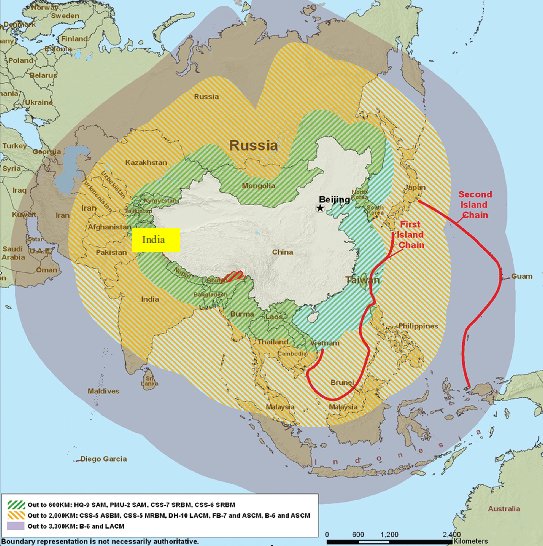Modernisation of PLA Navy (PLAN) is one of the important planks of China’s revolution of military affairs with indigenous characteristics. The Defence White Papers of China issued regularly after every two years have laid great emphasis on development of power projection capabilities which includes the expansion of the reach of thee Navy, that is, converting the coastal Navy to real blue water Navy besides modernizing its Air force and Strategic Rocket artillery forces.
In the latter half of year 2009 PLAN exhibited its Naval prowess during celebration ceremonies of its the 60th anniversary with participation from 29 foreign navy delegations. Avowed purpose was to promote exchanges between naval forces of different countries so as to work towards to building a “harmonious ocean” (in line with its policy of ‘harmonious world’, and harmonious negihbourhood). However, such exercises also serve as a strategic communication to deter competitors and likely adversaries and show case the country’s rising military might. China’s in a sense is a ‘restrained power’ as its Navy is unable to assert itself or expand its presence beyond the first Islands chain (see figure below) in the Pacific in the East because of superior U.S Naval presence. Perforce, if it has to expand its presence any where then it has to be towards South therefore its recent forays in the Indian Ocean like anti-piracy operations off the shores of Somalia. Further, it can lay legitimate claims of securing its sea lines of communications passing through the Indian Ocean because of its intensive energy and trade flows. Only country which may have some motive to impede such flows in future could be India if the underlying competition compounded by unresolved boundary issues reaches a point of conflict.
Late last year an Internet China National Radio report said that the China Aerospace Science and Industry Corporation will soon test-fire “a weapon under an important state weapons project.” Though no project was specified but the report carried a photo of a Dong Feng 21C medium-range ballistic missile, the same series as the Dong Feng 21D, and an artist’s drawing of such missiles attacking an American aircraft carrier. The final missile tests may come about in a year or two before its induction into PLAN.
With the above as the background one needs to assess as to how ASBM capability which is likely to be acquired by PLAN poses a challenge to the Indian Naval assets. In early December 2010, our Navy Chief Admiral Nirmal Verma speaking on the occasion of Navy Day observed that “As far as a weapon like ASBM is concerned, if it is operationally fielded, certainly it is a matter of concern”. There is a need to look at its deployment and put in place a mechanism to counter it. This was particularly important as India has plans to have for two Carrier Battle Groups (CBGs) in the future.
And ASBMs have been projected as weapons that could make CBGs look like sitting ducks, though the Indian Navy itself does not believe it to be so.
However, the PLAN effort is not limited to ASBM but covers a large range of weapon acquisition programs that includes anti-ship cruise missiles (ASCMs), land-attack cruise missiles (LACMs), surface-to-air missiles, mines, aircraft, submarines, destroyers and frigates, patrol craft, and amphibious ships. According to the US government sources and some other observers China is developing anti-ship ballistic missiles which are equipped with maneuverable reentry vehicles capable of hitting moving ships at sea. Due to their ability to change course, ASBM would be more difficult to intercept than non-maneuvering ballistic missile reentry vehicles. Evidently they would need to be integrated with suitable surveillance and target acquisition capabilities and command and control networks in addition to space based navigation and guidance assets. Such a capability with maneuverable warhead would be difficult to defeat. It is believed that China is developing an ASBM based on a variant of the CSS-5 (a modified DF-21) MRBM with a range of over 1750 KM as a part of its anti-access strategy. With this capability the US and other Navies operating around second island chain (see figure below) would be within reach.
Further, there are also reports that China is in the process of developing maritime surveillance and targeting systems that can detect ships and submarines and provide targeting information for Chinese ASBMs. These systems reportedly include land-based over-the-horizon backscatter (OTH-B) radars, land-based over-the-horizon surface wave (OTH-SW) radars, electro-optical satellites, radar satellites, and seabed sonar networks.

However, while China may be developing such capabilities for US-Taiwan contingencies such capabilities can easily be used against Indian Naval assets in the Indian Ocean especially in Bay of Bengal in combination with or without an air- land assault in the Northern disputed borders. Figure above gives the reach of ASBM missile i.e. CSS-5 (in yellow lines).
ASBM based in Tibet could target the Indian Aircraft Carrier/ other ships or even the shore-based naval installations with devastating effect in the event of hostilities. These also could be used in conjunction with LACMs and other kind of missiles with conventional warheads.
Therefore, what could be India’s response to this? Firstly, even when the U.S. has sea-based missile defence capabilities, its report of August 2010 on China’s Naval modernization highlights the difficulties of devising missile defence against maneuverable warhead of ASBM. Thus such a capability is a very potent capability and it appears from some of the reports that PLAN is very close to acquiring the same.
Defending own assets against China’s projected ASBMs could involve acquiring necessary BMD capability, reducing the signatures of own ships/assets, that make it more difficult for China to detect, identify, and track those ships, confusing the ASBM’s re-entry vehicles and employing suitable tactics and even changes in the fleet’s architecture to avoid kills. For instance, a U.S. Department of Defence report argues that Navy should shift over time to a more highly distributed fleet architecture.
According to one Indian admiral the challenge to India can be met by developing ‘deterrence at every level’ which includes India also developing similar capabilities to deter possibilities of such attacks besides an all round comprehensive military modernisation. However, acquisition of such capabilities would take time and effort. India has a very modest ballistic missile defence programme where timelines and benchmarks have been laid down but the programme does not cater for defence against ASBM as yet. India would need to go in for ship-based anti-ballistic missile like those possessed by the US Naval ships i.e. SM-3 BMD interceptor missiles. Even the U.S. Navy is looking for improving the capabilities of SM-3 system as also to acquire weapons and systems for disabling or jamming China’s long-range maritime surveillance and targeting systems, for attacking ASBM launchers, for destroying ASBMs in various stages of flight, and for decoying and confusing ASBMs as they approach their intended targets. Development and deployment of shipboard high-power free electron lasers and solid state lasers are some of the other alternatives which would be of immense use in countering ASBMs. Therefore, there would be a need for developing and procuring a sea-based mid-course and terminal defence BMD capability for some of the Indian destroyers/cruisers.
Secondly, Indian military has been acquiring network-centric capabilities and enhanced capabilities in the field of information warfare and is working towards acquiring additional space-based assets to meet diverse challenges including the one posed by China’s ASBM. Thirdly, the launching of nuclear submarine INS Arihant or ATV last year adds to the strategic deterrence capabilities and this can be termed as part of developing deterrence at every level.
Acquisition of military capabilities is being viewed by China’s neighbours as a destabilizing development. Strategic tensions between India and China need to be reduced but China has been increasingly looking for techno-military solutions to assert itself. Though the US remains its peer competitor and it would like to emulate the US yet acquisition of such capabilities creates apprehensions in the regional context. While ASBM is an instrument of China’s anti-access strategy we need to evolve our own anti-access strategy that would include countering ASBM besides upgrading our deterrence at every level.
-------------------------------------------
Published Date : January 18, 2011










Post new comment